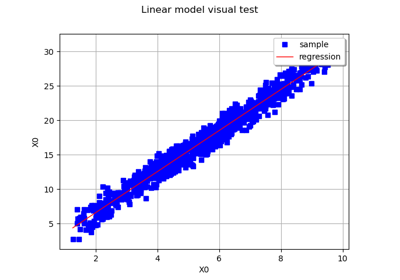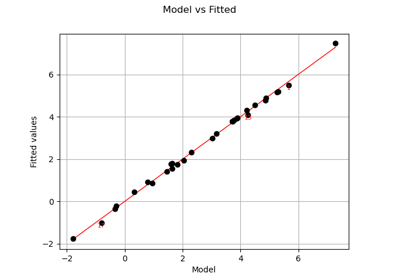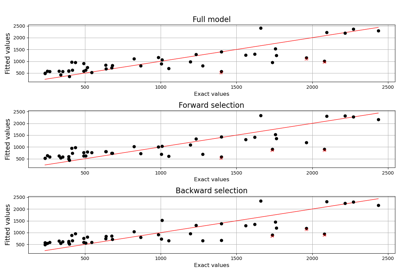LinearModelAnalysis¶
- class LinearModelAnalysis(*args)¶
Analyse a linear model.
- Available constructors:
LinearModelAnalysis(linearModelResult)
- Parameters:
- linearModelResult
LinearModelResult A linear model result.
- linearModelResult
See also
Notes
This class relies on a linear model result structure and performs diagnostic of linearity. This diagnostic mainly relies on graphics and a summary like function (pretty-print)
By default, on graphs, labels of the 3 most significant points are displayed. This number can be changed by modifying the ResourceMap key (
LinearModelAnalysis-Identifiers).Examples
>>> import openturns as ot >>> ot.RandomGenerator.SetSeed(0) >>> distribution = ot.Normal() >>> Xsample = distribution.getSample(30) >>> func = ot.SymbolicFunction(['x'], ['2 * x + 1']) >>> Ysample = func(Xsample) + ot.Normal().getSample(30) >>> algo = ot.LinearModelAlgorithm(Ysample, Xsample) >>> result = algo.getResult() >>> analysis = ot.LinearModelAnalysis(result)
Methods
Accessor to plot of Cook's distances versus row labels.
Accessor to plot of Cook's distances versus leverage/(1-leverage).
Accessor to plot of model versus fitted values.
Accessor to plot a Normal quantiles-quantiles plot of standardized residuals.
Accessor to plot of residuals versus fitted values.
Accessor to plot of residuals versus leverages that adds bands corresponding to Cook's distances of 0.5 and 1.
Accessor to a Scale-Location plot of sqrt(abs(residuals)) versus fitted values.
Accessor to the object's name.
getCoefficientsConfidenceInterval([level])Accessor to the confidence interval of level
for the coefficients of the linear expansion
Accessor to the coefficients of the p values.
Accessor to the coefficients of linear expansion over their standard error.
Accessor to the Fisher p value.
Accessor to the Fisher test.
getId()Accessor to the object's id.
Accessor to the linear model result.
getName()Accessor to the object's name.
Performs Cramer-Von Mises test.
Performs Anderson-Darling test.
Performs Chi-Square test.
Performs Kolmogorov test.
Accessor to the object's shadowed id.
Accessor to the object's visibility state.
hasName()Test if the object is named.
Test if the object has a distinguishable name.
setName(name)Accessor to the object's name.
setShadowedId(id)Accessor to the object's shadowed id.
setVisibility(visible)Accessor to the object's visibility state.
- __init__(*args)¶
- drawCookVsLeverages()¶
Accessor to plot of Cook’s distances versus leverage/(1-leverage).
- Returns:
- graph
Graph
- graph
- drawQQplot()¶
Accessor to plot a Normal quantiles-quantiles plot of standardized residuals.
- Returns:
- graph
Graph
- graph
- drawResidualsVsLeverages()¶
Accessor to plot of residuals versus leverages that adds bands corresponding to Cook’s distances of 0.5 and 1.
- Returns:
- graph
Graph
- graph
- drawScaleLocation()¶
Accessor to a Scale-Location plot of sqrt(abs(residuals)) versus fitted values.
- Returns:
- graph
Graph
- graph
- getClassName()¶
Accessor to the object’s name.
- Returns:
- class_namestr
The object class name (object.__class__.__name__).
- getCoefficientsConfidenceInterval(level=0.95)¶
Accessor to the confidence interval of level
for the coefficients of the linear expansion
- Returns:
- confidenceInterval
Interval
- confidenceInterval
- getCoefficientsTScores()¶
Accessor to the coefficients of linear expansion over their standard error.
- Returns:
- tScores
Point
- tScores
- getFisherPValue()¶
Accessor to the Fisher p value.
- Returns:
- fisherPValuefloat
- getFisherScore()¶
Accessor to the Fisher test.
- Returns:
- fisherScorefloat
- getId()¶
Accessor to the object’s id.
- Returns:
- idint
Internal unique identifier.
- getLinearModelResult()¶
Accessor to the linear model result.
- Returns:
- linearModelResult
LinearModelResult The linear model result which had been passed to the constructor.
- linearModelResult
- getName()¶
Accessor to the object’s name.
- Returns:
- namestr
The name of the object.
- getNormalityTestCramerVonMises()¶
Performs Cramer-Von Mises test.
The statistical test checks the Gaussian assumption of the model (null hypothesis).
- Returns:
- testResult
TestResult Test result class.
- testResult
Notes
We check that the residual is Gaussian thanks to
NormalityTest::CramerVonMisesNormal.
- getNormalityTestResultAndersonDarling()¶
Performs Anderson-Darling test. The statistical test checks the Gaussian assumption of the model (null hypothesis).
- Returns:
- testResult
TestResult Test result class.
- testResult
Notes
We check that the residual is Gaussian thanks to
NormalityTest::AndersonDarling.
- getNormalityTestResultChiSquared()¶
Performs Chi-Square test. The statistical test checks the Gaussian assumption of the model (null hypothesis).
- Returns:
- testResult
TestResult Test result class.
- testResult
Notes
The Chi-Square test is a goodness of fit test which objective is to check the normality assumption (null hypothesis) of residuals (and thus the model).
Usually, Chi-Square test applies for discrete distributions. Here we rely on the
ChiSquared()to check the normality.
- getNormalityTestResultKolmogorovSmirnov()¶
Performs Kolmogorov test.
Performs Kolmogorov test to check Gaussian assumption of the model (null hypothesis).
- Returns:
- testResult
TestResult Test result class.
- testResult
Notes
We check that the residual is Gaussian thanks to
FittingTest::Kolmogorov.
- getShadowedId()¶
Accessor to the object’s shadowed id.
- Returns:
- idint
Internal unique identifier.
- getVisibility()¶
Accessor to the object’s visibility state.
- Returns:
- visiblebool
Visibility flag.
- hasName()¶
Test if the object is named.
- Returns:
- hasNamebool
True if the name is not empty.
- hasVisibleName()¶
Test if the object has a distinguishable name.
- Returns:
- hasVisibleNamebool
True if the name is not empty and not the default one.
- setName(name)¶
Accessor to the object’s name.
- Parameters:
- namestr
The name of the object.
- setShadowedId(id)¶
Accessor to the object’s shadowed id.
- Parameters:
- idint
Internal unique identifier.
- setVisibility(visible)¶
Accessor to the object’s visibility state.
- Parameters:
- visiblebool
Visibility flag.
 OpenTURNS
OpenTURNS


